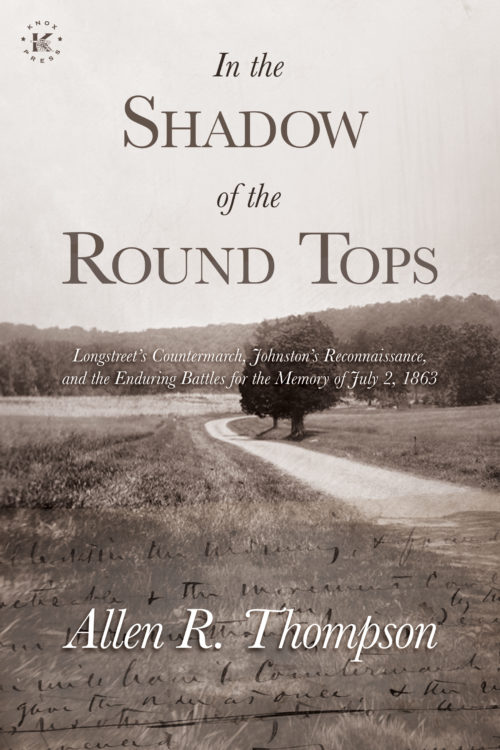
In the Shadow of the Round Tops: Longstreet’s Countermarch, Johnston’s Reconnaissance, and the Enduring Battles for the Memory of July 2, 1863
By Allen R. Thompson
Exciting new research lifts much of the fog surrounding the Battle of Gettysburg and offers a glimpse into what happened on that fateful day—July 2, 1863.
James Longstreet’s countermarch and Samuel Johnston’s morning reconnaissance are two of the most enigmatic events of the Battle of Gettysburg. Both have been viewed as major factors in the Confederacy’s loss of the battle and, in turn, the war. Yet much of it lies shrouded in mystery.
Though the battle is one of the most well-documented events in history, the vast majority of our knowledge comes from the words of the veterans and civilians who experienced it. Without action photography, video, or audio recordings, our primary window into what happened is the memory of those who were there. The story of the Battle of Gettysburg is simply the compilation of the memories of those who fought it. But memory is anything but objective.
Recognizing the multitude of factors that affect human memory, In the Shadow of the Round Tops explores how the individual soldiers experienced, remembered, and wrote about the battle, and how those memories have created a cloud over James Longstreet’s bewildering countermarch and Samuel Johnston’s infamous reconnaissance. Each soldier had a particular view of these historic events. Because many people saw part of the story, but no one saw all of it, each memory is a critical piece to the puzzle. By comparing the veterans’ memories and sifting through the factors that affected each memory, the picture of the countermarch, reconnaissance, and the entire battle, comes into sharper focus.
“Our knowledge of historical events is often based on a fragile combination of memory, bias, and flawed accounts written long after the fact. This is particularly true in the Gettysburg historiography when considering the controversies around Captain Samuel Johnston’s reconnaissance and Lt. General James Longstreet’s countermarch on July 2, 1863. Author Allen Thompson combines his knowledge of primary accounts and terrain to methodically deconstruct the myths, misconceptions, and falsehoods surrounding these events. After reading In the Shadow of the Round Tops, you will reconsider much of what you think you know and have more apparent answers to the debates that continue to haunt Gettysburg’s second day.”
–James A. Hessler, Gettysburg Licensed Battlefield Guide, author of Sickles at Gettysburg (2009) and Gettysburg’s Peach Orchard (2019), co-host of The Battle of Gettysburg Podcast
“Allen Thompson has compiled the definitive analysis of the march by Longstreet’s Corps to strike the Union left on the second day of the Battle of Gettysburg, an event that would generate charges and counterattacks between former Confederate officers to rival the bloody battle itself. This is a must read for those interested in the Confederate command system at Gettysburg and the influence of those who defended their decisions that fateful day.”
–John S. Heiser, National Park Service (ret.)
“Few Civil War battles evoke as much emotion and controversy as Gettysburg, particularly in assessing the performance of leading generals such as James Longstreet. The subject of much recent scholarship, Author Allen Thompson takes a fresh look at Longstreet’s countermarch on July 2 and the available military intelligence that influenced the Confederate decision-making that fateful day. Thompson’s thought-provoking work is a worthy addition to the historiography of the war’s bloodiest battle.”
–Scott L. Mingus, Sr., co-author of If We Are Striking for Pennsylvania: The Army of Northern Virginia and the army of the Potomac March to Gettysburg
“In the Shadow of the Round Tops is the definitive exploration of Longstreet’s march to the Confederate right at Gettysburg on July 2, 1863—one of the most controversial events in Civil War scholarship. Here, author Allen Thompson provides us with not only a deep dive into what happened that afternoon but also a splendid exploration of human memory, and how ‘Longstreet’s Fatal Delay’ became so important to post-war Confederate mythology in explaining away defeat. This is an excellent addition to Gettysburg literature, and I thoroughly enjoyed reading it.”
–David A. Powell, author of The Chickamauga Campaign
“Few episodes of American history have generated more controversies than the Battle of Gettysburg, many of which still rages today. One of the most intriguing controversies is precisely where Capt. Samuel Johnston, the engineer officer assigned to headquarters of the Army of Northern Virginia, went on his late-night reconnaissance of the Union left during the night of July 1-2, 1863. Johnston claimed to have reached Little Round Top, which would have required him to pass through Union cavalry videttes, none of whom reported any contact that night. Johnston’s report, in turn, influenced Gen. Robert E. Lee’s battle plan for July 2, and also led directly to the lengthy and time-consuming march and countermarch of Lt. Gen. James Longstreet’s Corps to the battlefield. Allen R. Thompson’s excellent micro-history, In the Shadow of the Round Tops: Longstreet’s Countermarch, Johnston’s Reconnaissance, and the Enduring Battles for the Memory of July 2, 1863 addresses these events in more detail than ever before. This deeply researched and well-written volume deserves a place on the bookshelf of any serious student on the second day of the Battle of Gettysburg.”
–Eric J. Wittenberg, award-winning historian
“Allen Thompson has done a masterful job of deconstructing all the Soldiers accounts on such a controversial subject. He treats them with consideration and respect. The parsing and sifting of Veteran’s memories to make sense of their experiences certainly was a factor about LTG James Longstreet’s Countermarch. In the Shadow of the Round Tops will be an important addition to a more accurate narrative of the pivotal events on July 2, 1863 at Gettysburg.”
–Rob Abbott, Gettysburg Licensed Battlefield Guide and Colonel USMC Retired








